Two Latvian food tours
As you’ve probably guessed, I love food. I can’t call myself a foodie, exactly, because I’m not choosy about what food I eat. I’m likely to enjoy whatever national cuisine I try, or at least find it interesting. Generally, I’m happy with anything from street food to chic food. But tasting the difference between one Michelin star and three stars? Nope, I couldn’t do it.
So with my disclaimer out of the way, this article looks at two Latvian food tours I took on my recent trip to Riga. Or, to be more precise, one tour about food in Riga and one that looked at artisanal food in the Latvian countryside.
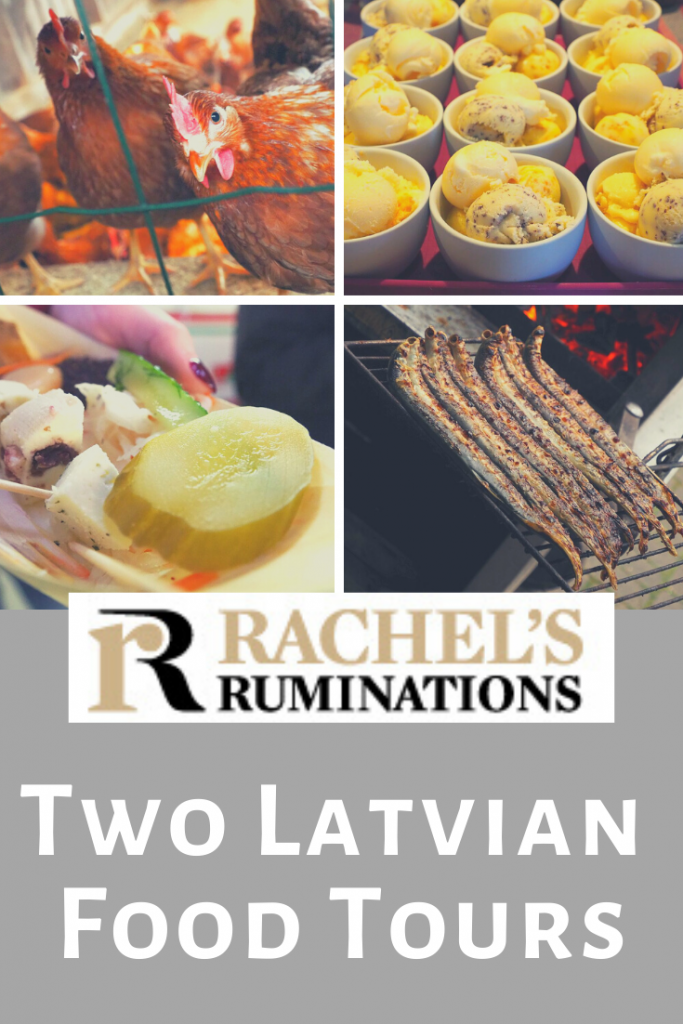
A disclosure: This article contains sponsored links: I received both tours for free as part of the Women in Travel Summit in Riga, Latvia. Nevertheless, all opinions are my own.
Another disclosure: This article contains affiliate links. If you click on one of them and spend money, I will receive a small cut of what you spend. This will not affect your price.
A Riga food tour
This Riga food tour, sponsored by #LiveRiga, was led by Arturs Trinkuns (“Archie”), a chef at 3 Pavaru Restorans (3 Chefs Restaurant), who sports an impressive handlebar mustache. We spent most of the tour at the Riga Central Market.
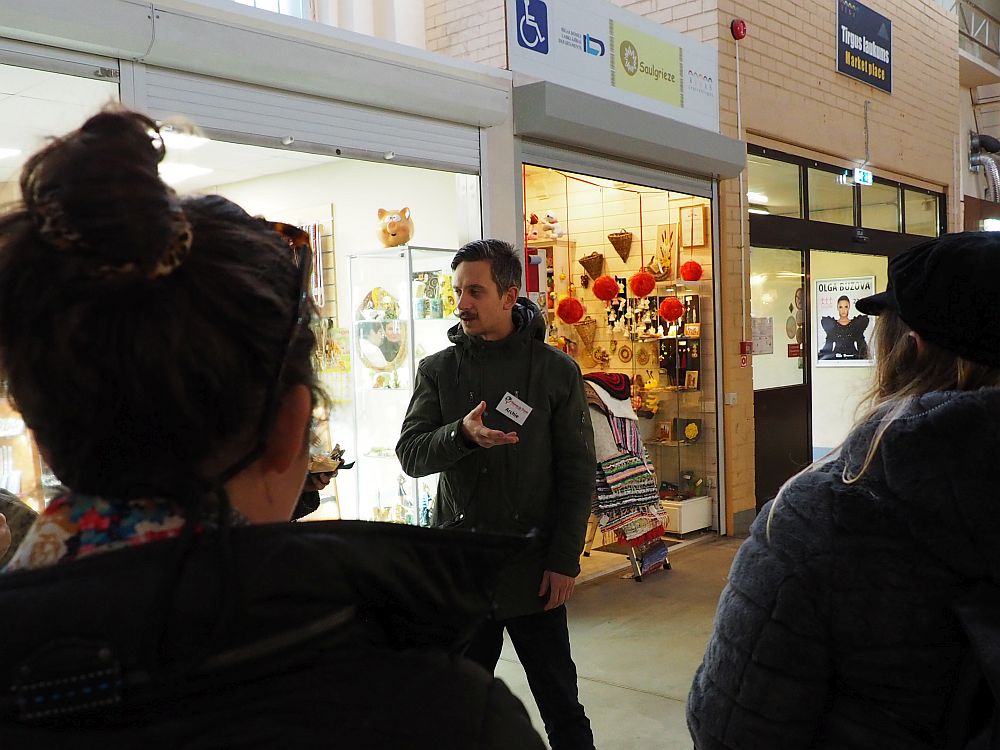
Riga Central Market
Riga Central Market is housed in five huge half-cylindrical halls that used to be zeppelin hangars, of all things. But it doesn’t even fit inside five zeppelin hangars: outside the buildings stand lots of stalls as well. Archie told us that the outside market closes down when the weather is too cold.
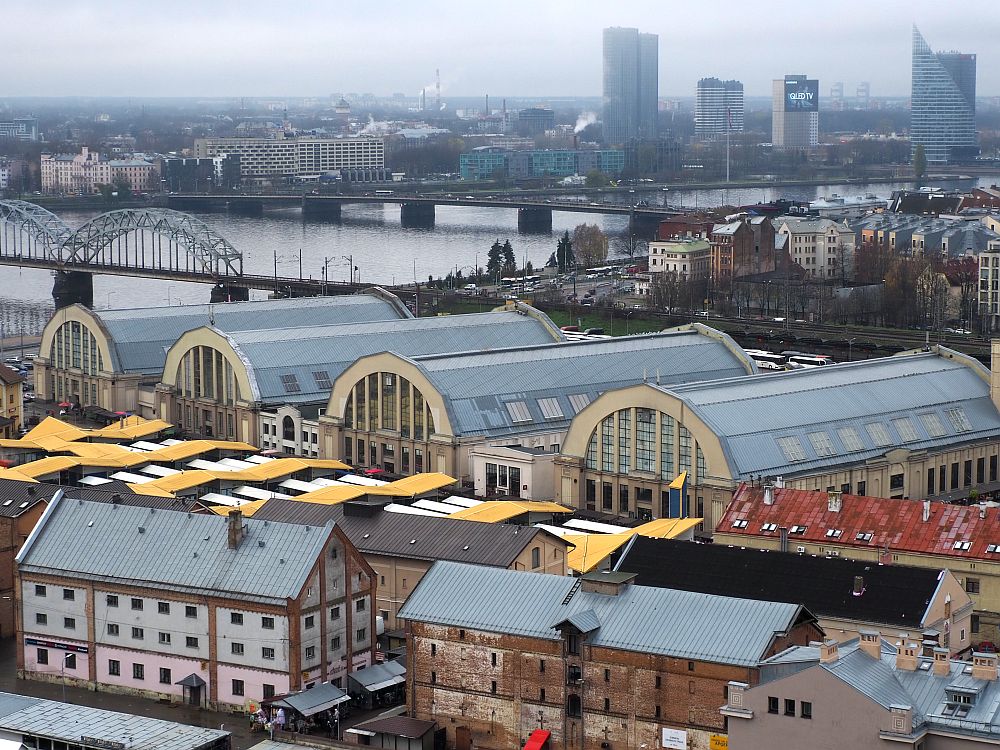
Outside the market, accompanied by a street band and some very loud and not-at-all-shy seagulls, Archie gave us a complete introduction to the basics of traditional Latvian cuisine.
Inside, he got more specific, pointing out local specialties. One important staple is heavy dark rye bread – and when I say heavy, I mean very heavy. Archie passed around a huge loaf for us to experience it.
Tasting
Another staple seems to be everything pickled and/or salted. At one stall the owner laid out a spread of items to taste and an array of pickled vegetables – mostly cabbage – took pride of place. Each was flavored differently and had a different color, depending on what it was pickled with: beet, for example, or pomegranate. How long it is pickled or salted affects the flavor as well.
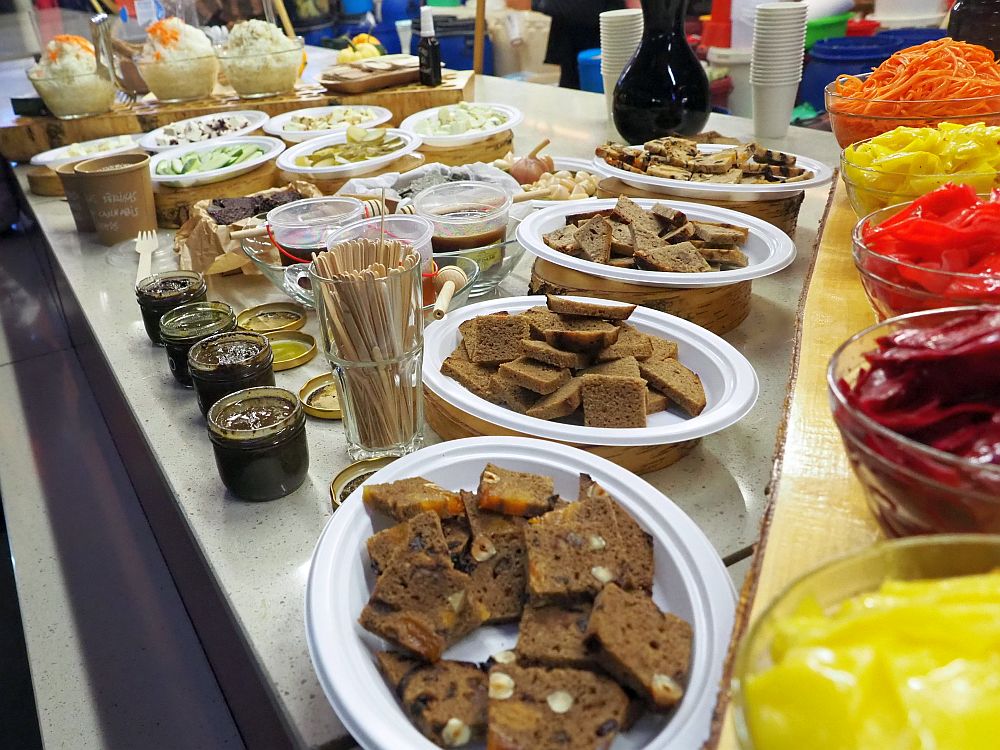
We tasted several kinds of cheeses, none of which seemed to have much flavor, but they combined well with sweeter items. These mild cheeses are made from curdling fresh milk and then straining the curdled milk, pressing what remains into a form. Its flavor comes from whatever is mixed into it or served with it. I also quite liked a small meat-filled bun that I think was speķrauši.
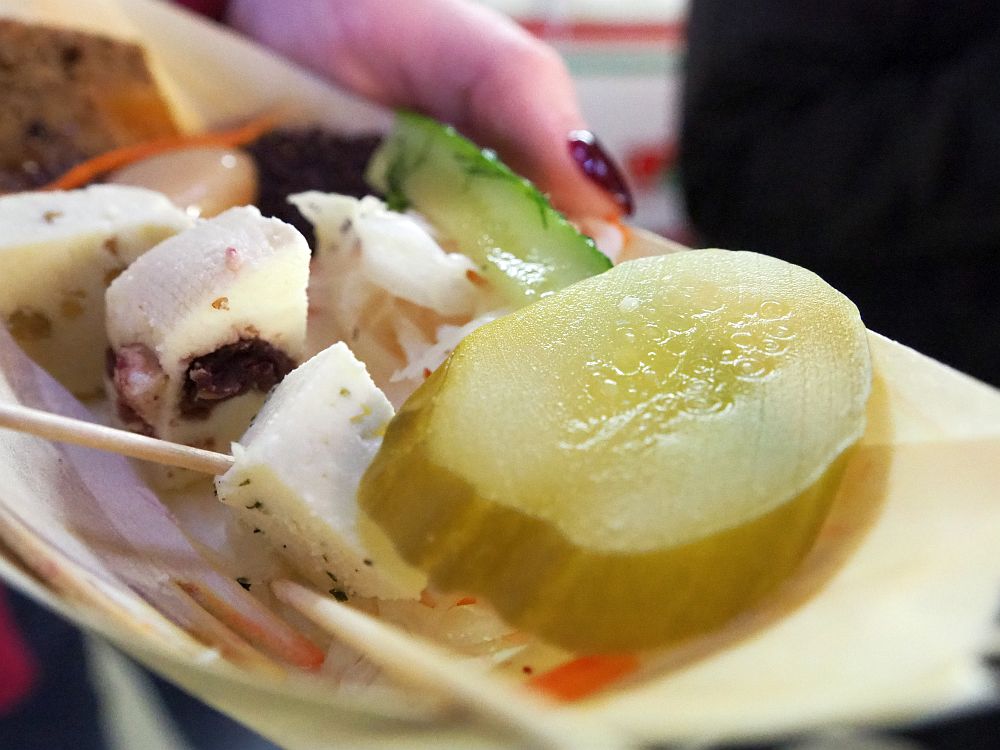
We stood for a while, nibbling the various items and listening to Archie’s explanations of how each was prepared, and I saw some older local women walk up quite boldly and help themselves to tastes as well.
After some time, we moved on to a quick walk through more of the market. Archie pointed out the fish section in particular. Fishing is a historically important industry for Latvia and fish continues to be a popular food.
The array of different kinds of fish on display is impressive, and the freshness of much of it was clear when we noticed fish that were still alive, twitching or gasping. The smell of smoked fish is as strong as that of fresh.
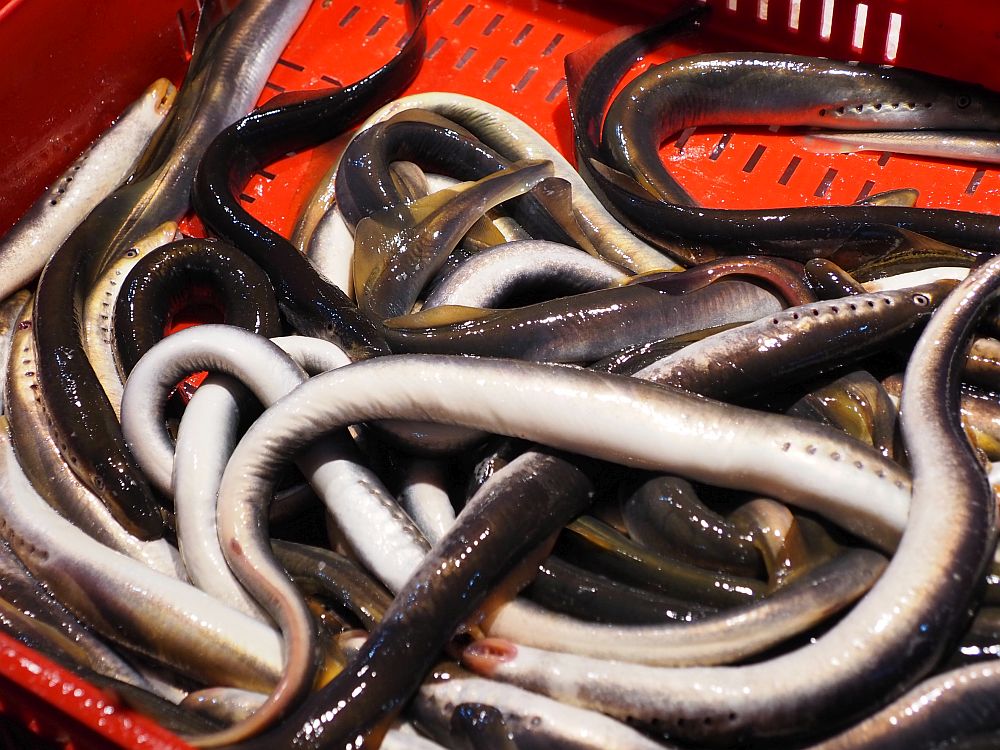
A note of warning: if you wander the market, be sure not to block the aisles between the market stalls. I got thumped on the back at one point by an elderly man when I didn’t get out of the way quickly enough. It didn’t hurt, but certainly startled me and angered me, especially given the fact that I was leaning on a cane at the time! And I wasn’t the only one this happened to. This market isn’t intended for tourists — I saw one souvenir stall, but that was all.
Traditional Latvian food
Much of the story that Archie related in the market struck me as similar to what I’ve heard on other food tours like in Krakow, Poland, or, for that matter, here in the Netherlands. Traditional food is often a story of scarcity and a rural way of life. What has become homey traditional food today was once vital to survival: being able to preserve food through smoking or pickling, being able to catch or grow the food for yourself.
For example, here in the Netherlands, the traditional food is dominated by things that could be grown here and, more importantly, kept through the winter. Potatoes, onions, bacon (smoked pork), carrots and kale (which can both be left in the field all winter until needed) are the basis of traditional Dutch food, along with milk products from cows and pickled herring from the North Sea.
It’s the same story in Latvia. That heavy rye bread lasts longer than lighter breads, and rye can be grown locally. People had to pickle or salt food to make it last through the harsh winters. And so on.
3 Pavaru Restaurant
Our only other stop on this Riga food tour was the 3 Pavaru Restaurant, where Archie is a chef. There, he showed us around the building – they have an extremely small kitchen! – and led us to tables in their event space upstairs.
In front of each of us was a sheet of baking paper. I assumed it was meant as a placemat until waiters started circling the tables with bottles, squirting a variety of sauces onto the paper. There was no rhyme or reason to their arrangement; they became just a multi-colored collection of squiggles on the paper.
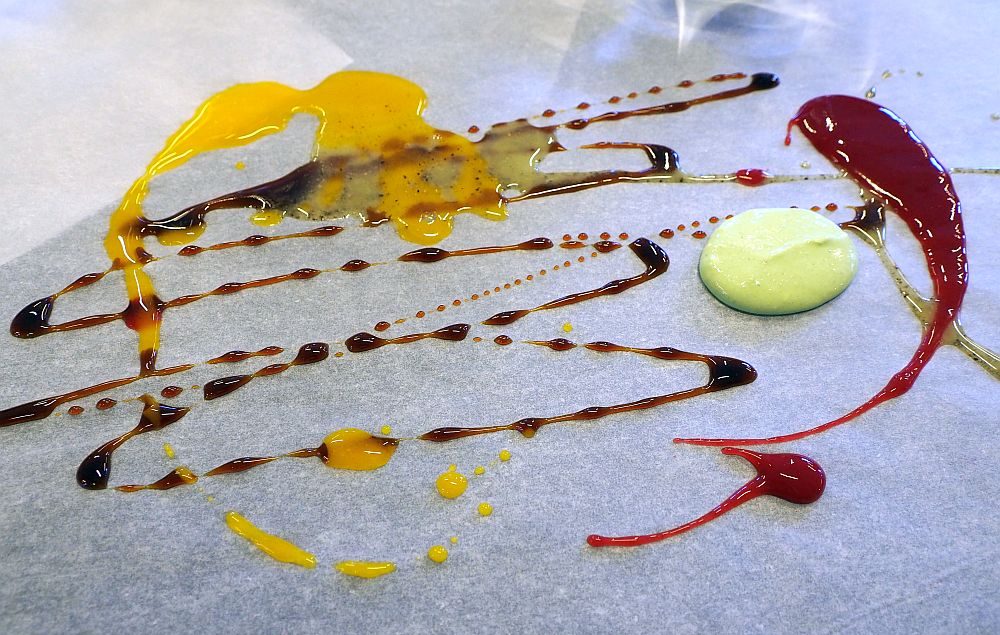
Baskets of bread appeared and the waiters explained what we were meant to do: we could use the bread to dip in the sauces. They suggested we taste the sauces separately, but also together, so we dug in. The bread was a light but nutty type I enjoyed as it was, and the sauces varied from what tasted like some sort of vinaigrette to sweeter, fruitier sauces.
This was all we ate at the 3 Pavaru Restaurant. It was good, but I can’t make any statement about their food in general. I can say that it has an excellent reputation as one of the top restaurants in Riga.
As for the tour, this was our last stop. The tour is not something that is normally available to visitors, unless you contact the restaurant itself and ask for a specially-arranged group tour. They also give cooking lessons by arrangement.
Try this regularly scheduled tour in Riga: Food tasting tour of the Riga Central Market (2 hours)
Artisanal Latvian food tour
A few days later, I took a second food tour, but this time taking us, a small group of bloggers, outside of the city. Sponsored by #liveRiga and The Latvian Element, which ran the tour, it lasted the whole day. The Latvian Element was planning to offer this tour, or something much like it, so our group served as their guinea pigs.
Eels
Our first stop fit well with Archie’s discussion of fish at the market, particularly lamprey eels. We visited a very small company called Krupis Carnikavas Nēģi that preserves eels. I looked up krupis and found that it means toad or frog, which fits with the collection of hundreds of ceramic, stone and plastic frogs adorning the yard where we met the company’s owners. Carnivaka is the location of the company, and nēģi means “eel.”
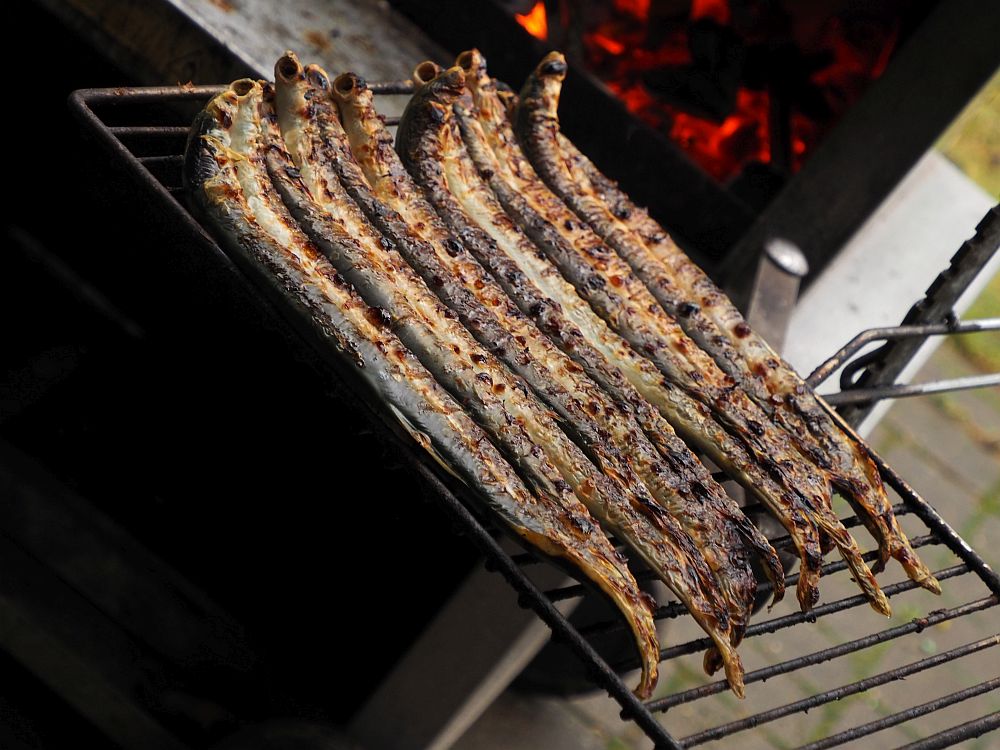
With our guide, Dārta, translating, the owner, Eduarda Skaveņecu, explained the whole process, from buying the fresh fish to salting it, which involves soaking it in marinade and later pressing the water out, and packing it. We learned more than we ever wanted to know about eels: Eduarda compared them to vampires, sucking the blood from other fish, and claimed that that is what makes them flavorful.
He also told us about himself, a former champion wrestler and later a wrestling trainer, and his wife, a former champion shooter, and how they ended up processing eels.
After his explanation, we stood around a table in the yard as another man, whose name I didn’t catch, cooked a batch of eels over a fire for us. When he was done, he showed us the right way to eat them: holding them up by the head, throwing our heads back and lowering them to our mouths, tail first. This is exactly how the Dutch eat their salted raw herring, except in their case it’s gills first, tail last.
It was tasty, I thought, though I would have preferred not to eat the entire fish. The texture of the spine was off-putting, I have to say. It was made better, though, by the mystery alcohol shots he gave us: some sort of local distilled drink, I think. Keep in mind that this was at about 10:00 in the morning.
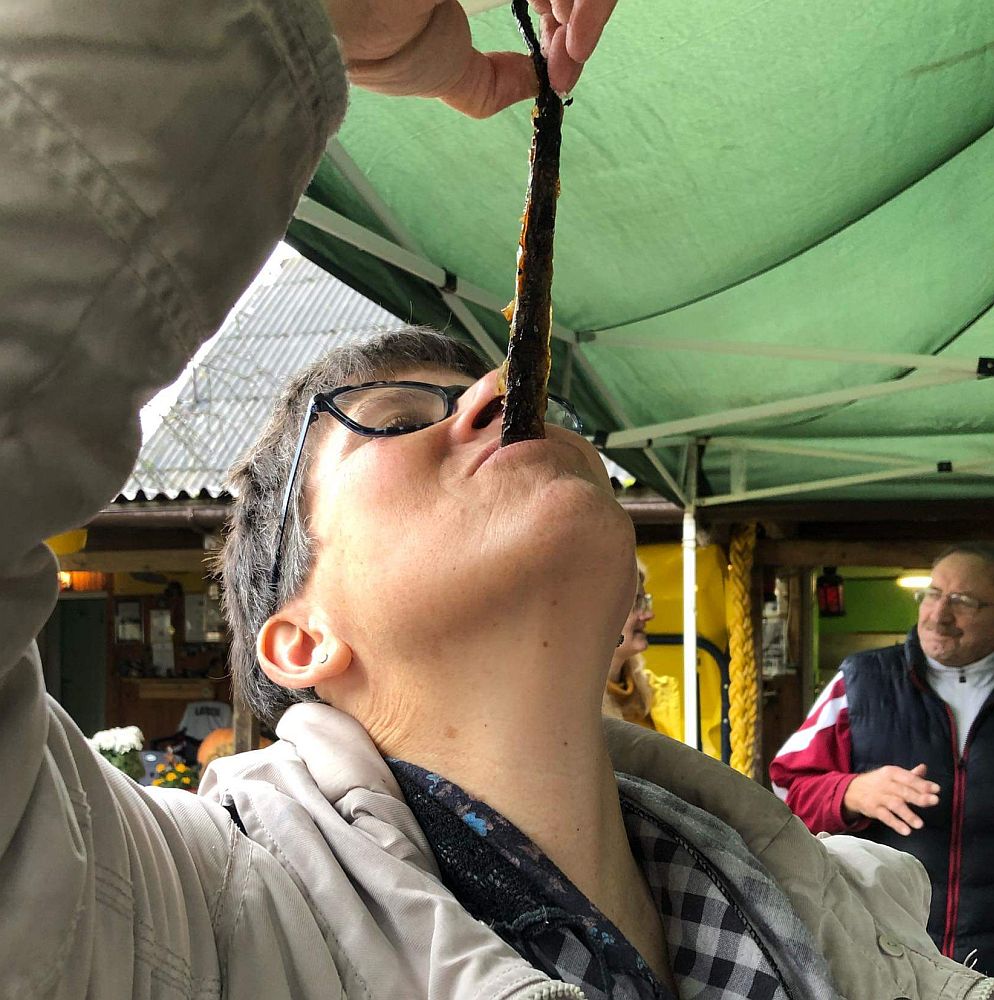
We thought that was it, but next we went indoors to sit around a table where we each got a small plate of sushi, made, of course, with eel. I liked that much better; it resembled tuna in that form. While we ate, Eduarda sang us a song.
Ice cream
Our next stop, at lunch time, was an ice cream maker called Gogelmogels in a village called Stiene. Like the eel company, this is an artisanal enterprise owned by a husband and wife pair, producing ice cream in their own house. The husband explained how the couple had moved to the countryside from Riga, becoming small farmers at first until they saw how much people liked the small amount of ice cream they produced. Now they focus on ice cream, mostly supplying it directly to Riga restaurants.
The ingredients are for the most part locally produced; the cream comes from local dairy farmers. The main difference between it and other ice creams is that it contains egg yolk. This explains the name: Gogelmogels is a play on kogel mogel, a traditional Eastern European dessert made mostly from egg yolks and sugar.
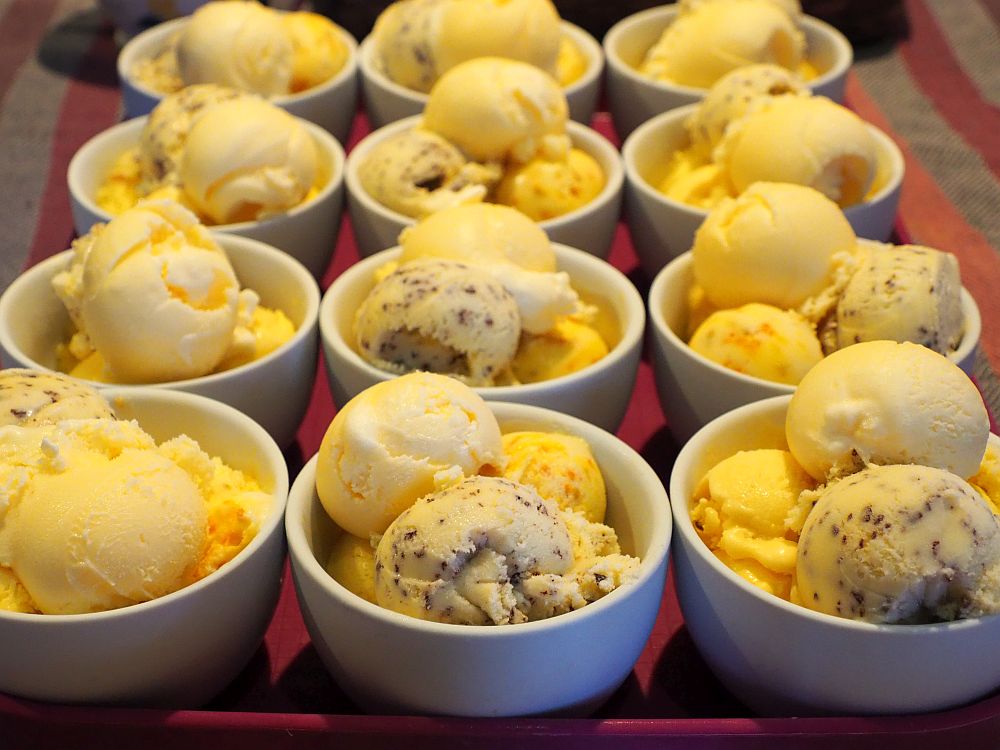
It was indeed delicious ice cream. We got a full bowl containing five small scoops: vanilla, stracciatella, sea buckthorn, bee pollen and halvah. I particularly liked the halvah.
Next we went to the nearby hen house, where the wife of the couple raises chickens to supply their own eggs for the ice cream. She proudly showed us a system she designed where the chickens lay their eggs on shelves. By sliding up a board in the wall, she can access the shelves to take the eggs without opening the henhouse door and risking escapees. The same goes for feeding them: she places the food in a sort of trough along the fence and the chickens can pick at it when they want.

Krimulda manor house
Never mind that we hadn’t had a filling lunch; our next stop was a wine-tasting, but first we got a tour of the grounds of Krimulda manor house, where the winery is, near Sigulda. Our guide was the winemaker, Jānis Mikans.
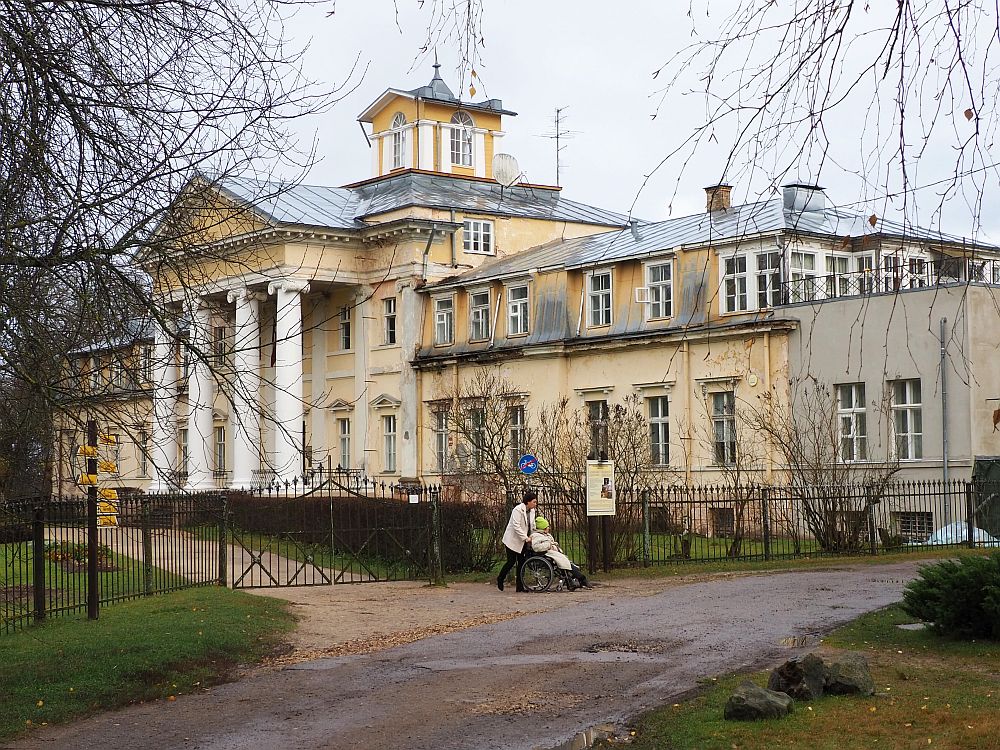
The manor house itself has an interesting history. Built in the 19th century by the Lieven family to replace an older castle that burned down in the early 17th century, it became a Red Cross sanatorium for tuberculosis patients after World War I. Facing the rather down-at-the-heels main house is a long, single-story, curved wooden building with high windows. These were rooms for the patients, allowing them lots of air and light.
Nowadays the manor is a rehabilitation center, spa and hotel/hostel. We only saw the entrance and one hallway, which seemed quite institutional and clinical on the inside. It offers a range of treatments including physiotherapy, massage and so on. The manor also can be hired for events and it has hotel rooms, hostel accommodations and cottages. We didn’t see any of these spaces, so I can’t attest to their quality, but its ratings are excellent on Booking.com.
To book a room at Krimulda Manor, click on this link.
Nearby are the ruins of the original Krimulda Castle: not much left but overgrown piles of large stones. We also passed a Swiss-style building that was (or perhaps still is) used as housing.
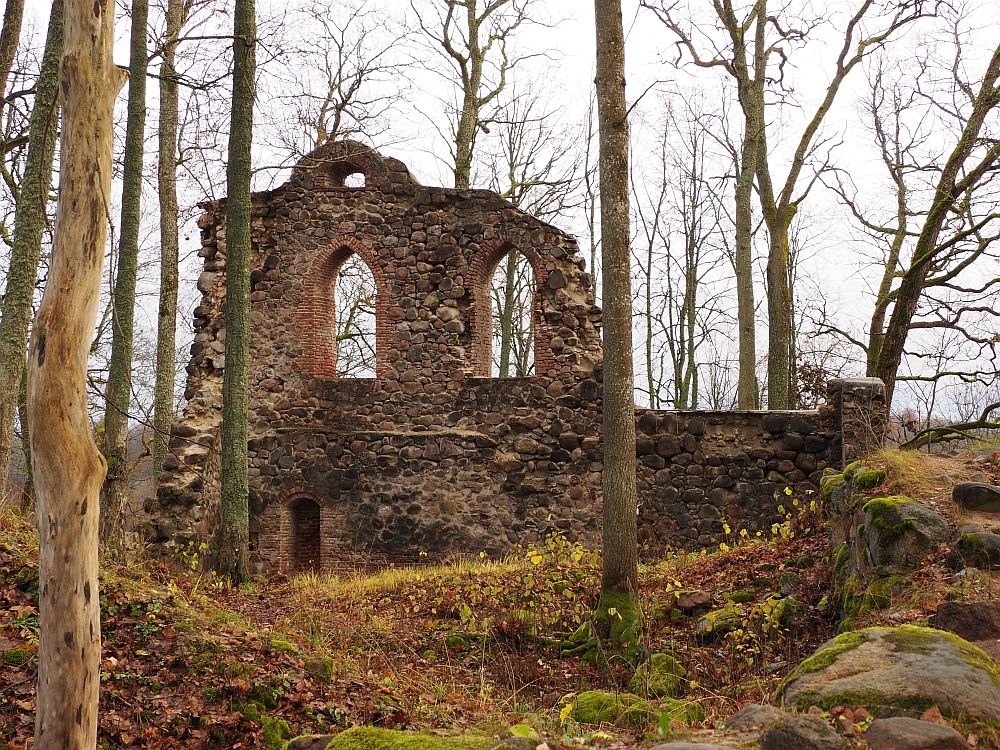
Cremon winery
Getting down to the business of Latvian national food, or, in this case, drink, we were shown to the Cremon winery on the grounds of the manor, where we sat around the edge of a room with a big table down the middle. The table held an array of bottles holding colorful liquids along with some small nibbles: hard sweet biscuits, crackers, and small pieces of cheese.
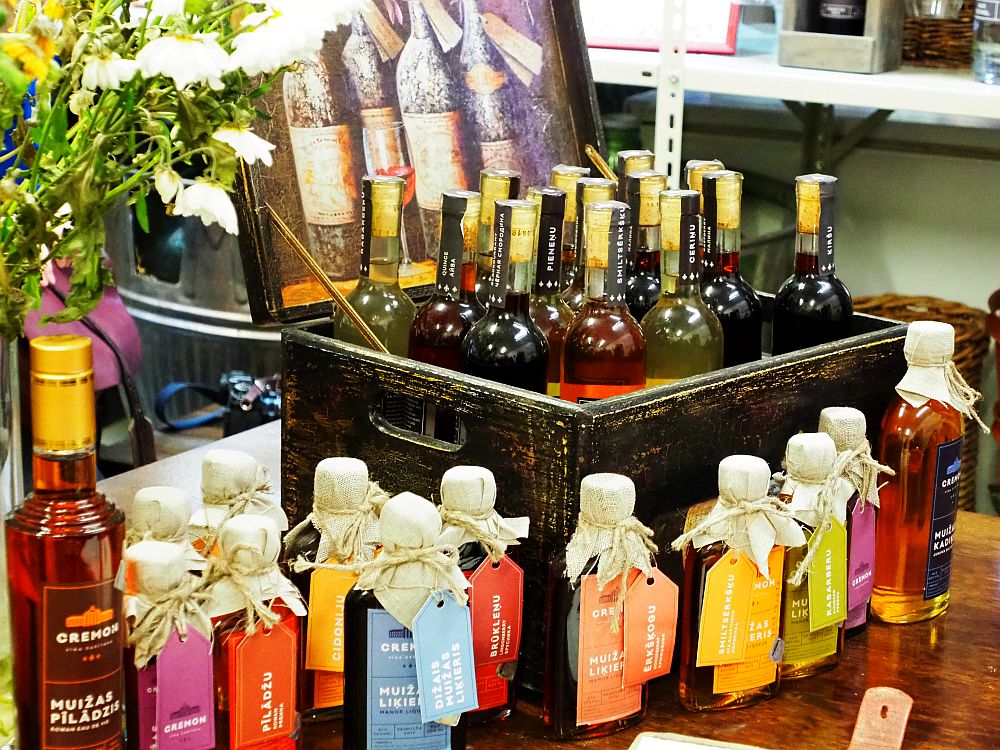
While everyone was using the word “wine,” Cremon manor wine is not made from grapes, which don’t grow well in the Latvian climate. These are dessert wines, made with various flowers and berries like raspberry and rhubarb and gooseberry, much of it picked locally on the manor’s land.
First we tasted a dandelion wine and, while I generally like almost anything sweet-tasting, this wasn’t my favorite. We tasted a few others, and I particularly liked the cranberry wine. Given that we’d had only ice cream for lunch, the wine quickly went to my head, and many of the others on the tour too, I suspect, so it became quite a jolly gathering.
Cable car ride
We never actually took the cable car ride we were scheduled for. Krimulda Manor’s land sits on the Gauja River and a cableway takes visitors from there across the Gauja river valley. About a month earlier than our visit it must have been spectacular with the fall foliage. From the cable car, apparently, three medieval castles are visible as well as a big bobsled track.
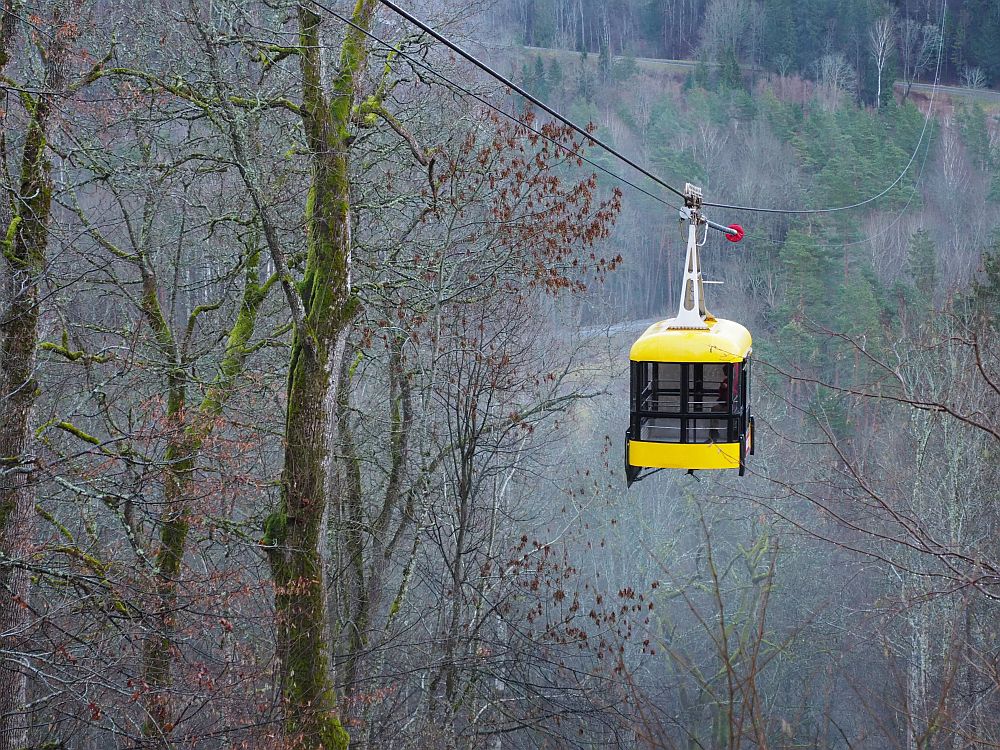
But we were running behind and had dinner reservations. The cableway only holds one cable car that goes back and forth for about a kilometer each way. We would have had to go in two trips and, in any case, it had gotten quite misty and dusk was falling, so we wouldn’t have seen much. We decided to forego the ride and set off for our next and last stop. (And I admit to a sense of relief: I’m a bit phobic.)
Mālpils manor house
For me, this stop was the highlight of our Latvian food tour, partly because of the excellent quality of the food, and partly because it gave us a chance to sit and enjoy each other’s company.
Mālpils Manor has a similar history to Krimulda. The original castle on the site was destroyed in the 17th century and replaced by a manor house in the 18th century, but this house burned down during riots in the first Russian Revolution in 1905.
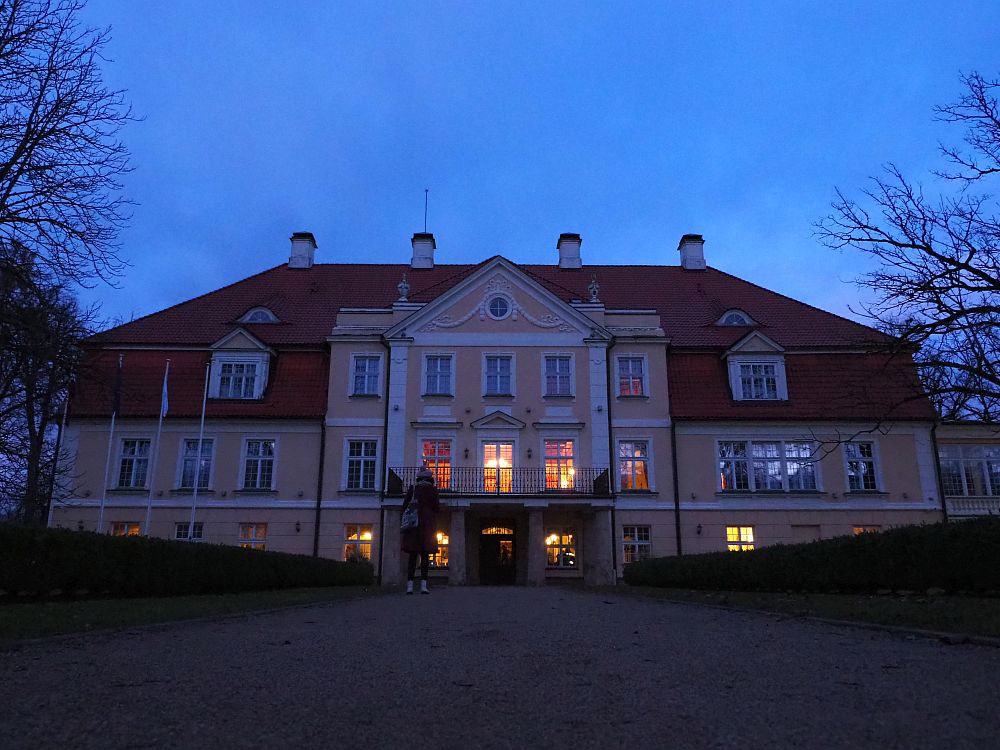
The current building arose on the site soon after that. However, in line with Latvia’s history, it became a school after the 1920 agrarian reforms and then a sanatorium. It was nationalized under the Nazis and later the Soviets, housing a technical school and, from the 1960s, an agricultural museum.
When Latvia regained its independence, the house was returned to the pre-war owner’s heirs, who sold it in 2003. The manor today is the result of a thorough renovation and restoration of the inside and outside under the new owners.
Today, Mālpils is a hotel and event space, like Krimulda, but clearly more upscale. We only saw the outside and the dining room on the ground floor, so I can’t be sure of the rest. The exterior, though, and the restaurant inside were simple and elegant and in good repair. Its website calls it a design hotel and one of the best restaurants in Latvia.
To book a room at Mālpils Manor, click here for Booking.com.
Restaurant at Mālpils Manor
Our meal was in three courses, with a couple of choices for the main course. I have no idea what kind of soup our starter was, but it was tasty, with a delicate, mild flavor. I chose a pork dish for my main course; again, it was elegantly presented over roast potatoes and carrots with sautéed mushrooms and a mashed paste of parsnips (I think). The dessert was a chic version of an Eton Mess, with some sort of cream, fresh berries and meringue, all arranged prettily on a plate surrounded by a pine cone and evergreen twigs.

As participants in a conference for women in travel, we were particularly pleased at the end of the meal to find out that the chef is female. Her name is Aija Gabrāne and she is well-respected for her well-thought-out and well-presented seasonal menus.
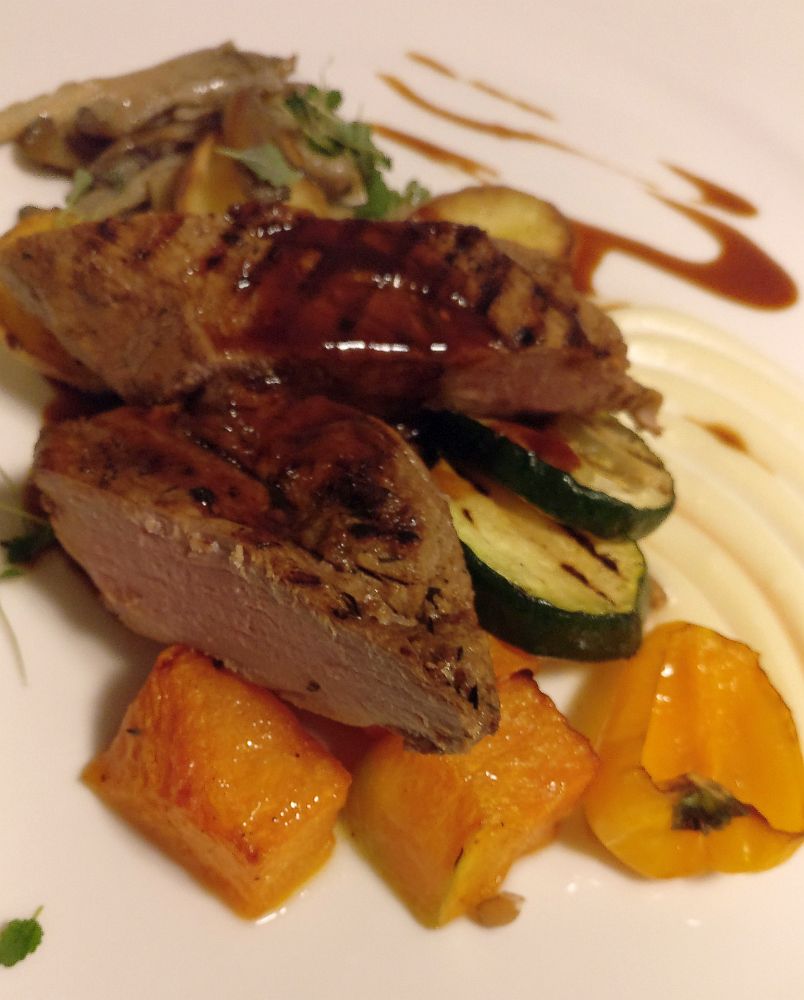
Dārta from The Latvian Element asked us for feedback as we drove back to Riga, which we gave her, so I can’t guarantee that your Latvian food tour will be the same. What I can say is that the strength of the tour was that we got to visit small-scale, local artisanal producers who we never would have known about before. It’s not really a course in Latvian national food, though we did learn about traditional foods, it’s more about what’s going on today in the world of food in Riga and the region.
Latvia food
Given that I was in Latvia for only about a week to attend a travel conference, it feels like my visit outside the conference ended up primarily focused on food. This turned out to be for the best, since the weather was grey and cold in November. Not only that, I had injured my foot and was walking much of the time with a cane, so the usual sightseeing I do – wandering through historic neighborhoods, photographing architecture and generally walking a lot – wasn’t possible. It was great to delve into foodie topics for a change.
It was clear to me that in Latvia, like most places, traditional foods are still treasured. At the same time, the Latvian food scene is innovative and open to experimentation, judging by the two restaurants I visited on these tours and others I enjoyed in Riga. The shift to a farm-to-table emphasis that is happening here in Western Europe is happening there as well.
Have you visited Latvia? Add a comment below about food in Latvia. What did you like? What didn’t you like?
My travel recommendations
Planning travel
- Skyscanner is where I always start my flight searches.
- Booking.com is the company I use most for finding accommodations. If you prefer, Expedia offers more or less the same.
- Discover Cars offers an easy way to compare prices from all of the major car-rental companies in one place.
- Use Viator or GetYourGuide to find walking tours, day tours, airport pickups, city cards, tickets and whatever else you need at your destination.
- Bookmundi is great when you’re looking for a longer tour of a few days to a few weeks, private or with a group, pretty much anywhere in the world. Lots of different tour companies list their tours here, so you can comparison shop.
- GetTransfer is the place to book your airport-to-hotel transfers (and vice-versa). It’s so reassuring to have this all set up and paid for ahead of time, rather than having to make decisions after a long, tiring flight!
- Buy a GoCity Pass when you’re planning to do a lot of sightseeing on a city trip. It can save you a lot on admissions to museums and other attractions in big cities like New York and Amsterdam.
Other travel-related items
- It’s really awkward to have to rely on WIFI when you travel overseas. I’ve tried several e-sim cards, and GigSky’s e-sim was the one that was easiest to activate and use. You buy it through their app and activate it when you need it. Use the code RACHEL10 to get a 10% discount!
- Another option I just recently tried for the first time is a portable wifi modem by WifiCandy. It supports up to 8 devices and you just carry it along in your pocket or bag! If you’re traveling with a family or group, it might end up cheaper to use than an e-sim. Use the code RACHELSRUMINATIONS for a 10% discount.
- I’m a fan of SCOTTeVEST’s jackets and vests because when I wear one, I don’t have to carry a handbag. I feel like all my stuff is safer when I travel because it’s in inside pockets close to my body.
- I use ExpressVPN on my phone and laptop when I travel. It keeps me safe from hackers when I use public or hotel wifi.


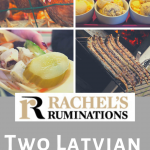

Both tours sound incredible! I love the huge variety of foods and experiences. Riga far exceeded my expectations, and yet I could easily return and have whole new experiences. So much to see, do, and taste there!
Such an interesting story. I learned a lot. Good place to go; Latvia!